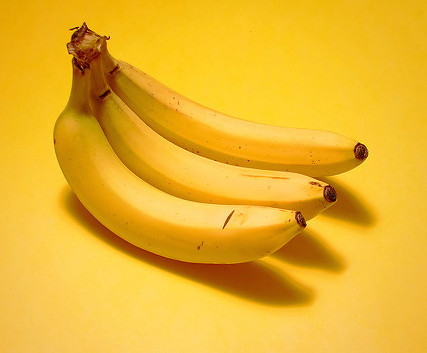Image: Flickr/Rick Harris
Do you know what you like? That may sound like a dumb question, but disentangling all the different reasons for loving one thing and hating another can be tricky. Take bananas, for instance. Many people pronounce a clear preference for a certain level of ripeness when it comes to their bananas. But is this preference related to the actual taste of bananas of different ripeness, or is due to other cues, such as the shelf life of the banana? Well, here comes the science! These researchers compared people’s preferences for peeled and unpeeled bananas of varying ripeness — either just turning yellow, or yellow with brown spots. Despite a clear stated preference for non-spotted bananas, if the participant didn’t see the peel, there was no difference in overall liking of the two kinds of bananas. The authors suggest that people think they like less ripe bananas because they last longer. Now THAT’S bananas.
Visually suboptimal bananas: How ripeness affects consumer expectation and perception.
“One reason for the significant amount of food that is wasted in developed countries is that consumers often expect visually suboptimal food as being less palatable. Using bananas as example, the objective of this study was to determine how appearance affects consumer overall liking, the rating of sensory attributes, purchase intention, and the intended use of bananas. The ripeness degree (RD) of the samples was adjusted to RD 5 (control) and RD 7 (more ripened, visually suboptimal). After preliminary experiments, a total of 233 participants were asked to judge their satisfaction with the intensity of sensory attributes that referred to flavor, taste, and texture using just-about-right scales. Subjects who received peeled samples were asked after tasting, whereas subjects who received unpeeled bananas judged expectation and, after peeling and tasting, perception. Expected overall liking and purchase intention were significantly lower for RD 7 bananas. Purchase intention was still significantly different between RD 5 and RD 7 after tasting, whereas no difference in overall liking was observed. Significant differences between RD 5 and RD 7 were observed when asking participants for their intended use of the bananas. Concerning the sensory attributes, penalty analysis revealed that only the firmness of the RD 7 bananas was still not just-about-right after tasting. The importance that consumers attribute to the shelf-life of food had a pronounced impact on purchase intention of bananas with different ripeness degree. In the case of suboptimal bananas, the results demonstrate a positive relationship between the sensory perception and overall liking and purchase intention. Convincing consumers that visually suboptimal food is still tasty is of high relevance for recommending different ways of communication.”
Related content:
Chimps in glasses…for science!
On the purpose of saying “ow” when you hurt yourself.
Rectal salami.
